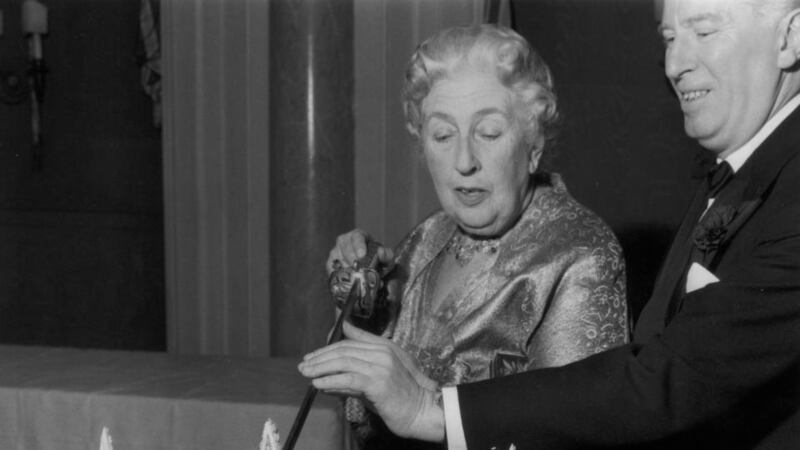Agatha Christie's The Mousetrap is theatrical Bisto: traditional, familiar and very British. It's a play so well constructed that all you have to do is add water and the meat juices – in the form of jobbing actors, actually – and it works. Now in its 60th year, The Mousetrap is the longest-running play in the world and, for many visitors to London, a must-see along with Madame Tussauds and the Tower of London. It is full of eccentricities, including the fact that Christie gave the royalties from The Mousetrap to her grandson, Mathew Prichard, when he was nine years old.
Was it liberating or oppressive to receive such a gift? “Liberating to an extent,” says Prichard, CBE, from his seat in the bar of St Martin’s Theatre in West Street, London, which has been home to the play for 38 years of its 60-year run. With the sunburned face of a keen golfer, he has played in Ballybunion, Waterville and Killarney.
" The Mousetrap is more than a play now. It's almost an industry," he says. "It's a family charity, and royalties are used to benefit arts events in Wales, where I live, and the Mousetrap Theatre Projects, which takes people from disadvantaged backgrounds, who have special needs or a disability, to London's best theatre."

At 21, Prichard inherited the royalties of all Agatha Christie’s work, substantial considering that her 66 detective novels have sold close to four billion copies, ranking her up there with the Bible. They were sold to Chorion Media Group in 1998 and changed hands again last year. Prichard had sold the rights to the play when was in his twenties, to avoid inheritance tax, but got them back in 2001 and has since given more than £1 million in royalties to the Mousetrap charity.
The Mousetrap has run continuously since 1974 in the evocative wood-panelled St Martin's Theatre, built in 1916, a 550-seat gem so fusty and charming in that tight-fisted country-house English way (just try finding a means to dry your hands in the ancient toilets) that it is part of the experience of the play. Built to give the impression of a private theatre, its walls are adorned with memorabilia – such as a photograph of a 20-something Queen Elizabeth II attending the play in a full-skirted Hartnell gown and mink stole – and huge, neck-craning oil portraits of the ancestors of Lord Willoughby de Broke, whose grandfather built the theatre.
The set and the “house” are almost as one, giving the feeling of travelling back in time and sitting in a giant doll’s house. On the mantelpiece on the set, the original clock from the first production holds forth and only recently was a leather chair, worn ragged by generations of actors’ bottoms, replaced with a new version.
This sense of history is important to all involved in The Mousetrap , and to many of the audience members. On the evening I visited to see the 25,170th performance, American tourists blocked the aisles photographing the theatre's interior. The sense of being in a time capsule is so vivid, one imagines that if ad man Don Draper (the chief protagonist of Mad Men ) were on a worktrip to London, this is the play that he would see. A cartoon on the wall of the bar calls the play "The Eurotrap", while another shows a couple with the line, "But Charles, you know we always see The Mousetrap on the first Wednesday of the month."
The ancient wind machine, used for sound effects, is still in use, although a modern digital recording augments it these days. Since its premiere in 1952, audiences have heard the voice of Derek Guyler as the radio announcer (now crisply digitalised). And just outside the prop room, the stage door sign is so emblematic of everything an old stage door sign should be, that the week I visited, Simon Cowell was there to have himself photographed beneath it, accompanied by two impossibly leggy women (or so I’m told).
On the more wholesome Bisto side, The Mousetrap has seen generations of families attend, some coming back with grandchildren and great-grandchildren, and celebrating anniversaries at the theatre.
All of which is a way of asking an awkward question: will The Mousetrap taken out of its historical London context, at its address straight across from The Ivy (where the actors socialise), and marked by the new Agatha Christie memorial in Leicester Square, translate to the 3,000-seat Bord Gáis Energy Theatre, as beautiful and majestic as it is?
Artistic director Denise Silvey, who spent childhood summers in Malahide across the road from Eamon Andrews with her Irish mother Molly McKinney, originally from Blackrock, Co Dublin, has brought the play to Singapore and China, where it is “more popular than Shakespeare” because the play’s appeal is universal. The touring set is larger to fill the space and the cast specially chosen for the rigours of touring. Both in the theatre and on tour, the cast works 10 months on the trot without a day off – matinees included – before being replaced by the next cast. Auditions of 1,000 actors are held every 10 months in the tiny theatre bar where, over the past 60 years, 403 actors have won roles that pay “above equity rates, a workable salary,” says Silvey.
The production that comes to Dublin will feature some familiar faces from EastEnders : Steven France as the fey Christopher Wren, Jemma Walker as Mollie, Clare Wilkie as Miss Casell and Elizabeth Power as Mrs Boyle. Silvey's husband Graham Seed ( The Archers ) will play Major Metcalf; Karl Howman ( Brush Strokes ) and Bruno Langley ( Coronation Street , Dr Who ) also have roles.
“It’s old school, like a family more than a factory; everybody talks about the play with such love,” Silvey says. She herself was cast as Miss Casewell in the 43rd and 50th years of the play. “All the living actors meet together one evening a year and we all have our stories.” This begs the question, “Any none-living actors? Any ghosts?” There is one non-acting personage, Meggie, who since her death in 1923 haunts St Martin’s “when something awful happens”, but the non-living actors tactfully stay away.
The ensemble cast are chosen not just for acting calibre, says Silvey, but for their ability to get along with others and work as a team, since eight performances per week for 10 months without a break requires equilibrium. “There are no egos,” says Silvey, who is as much a human resources manager as an artistic director.
The most famous actor to have taken part remains the first: Richard Attenborough, who as Detective Sergeant Trotter appeared with his wife, Sheila Sim, as Mollie Ralston at the world premiere in Nottingham in October 1952, exactly eight months after a 25-year-old Elizabeth Windsor became queen of England.
The play is a whodunit, of course, and keeps audiences guessing until nearly the end in a sort of theatrical Cluedo – a boardgame published in 1949, incidentally. Eight people are trapped by a snowstorm in the Great Hall of Monkswell Manor in 1952 England.
The young couple who have inherited Monkswell are making a go as guest-house proprietors on scant resources, when they discover that there is a murderer in their mist and begin to stumble on bodies. Rather racy for its time, one imagines, the dialogue wittily shows people being barely polite in an atmosphere of growing pathos and stiff upper lips.
It’s an amusing and entertaining evening in the theatre that will appeal to all ages. Audiences at the Bord Gáis Energy Theatre would do well to go with groups of family and friends and make an evening of it, enjoying Grand Canal Square and refreshments in the theatre bars.
Prichard thinks the play should do well here. “The Agatha Christie business is recession-proof. When times are hard people go back to the reliables.”
Agatha Christie's
The Mousetrap
at Bord Gá
is Energy Theatre opens
on June 24th











